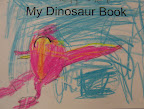Children's drawings reflect their observations—and their thoughts
By Peggy Ashbrook
Posted on 2010-11-14
 Here’s what I love about the early childhood education community: the communication, sharing thoughts and wonderings!
Here’s what I love about the early childhood education community: the communication, sharing thoughts and wonderings!
In the November 2010 Early Years column in NSTA’s elementary school journal, Science and Children, I wrote about how children’s drawings, discussions and writings document their work. I heard additional thoughts back from two educators.
I wrote that, “A child’s drawings of a beetle with a happy face or a tree with a round circle of leaves on top of a straight trunk are typical representations, which are more like symbols than actual observations. With repeated observation and documentation, children include more details and provide fuller dictations, even if they are not able to draw accurately. A typically developing child who spent a lot of time observing and handling Tenebrio beetles at 4 and 5 years old created wobbly drawings and offered detailed (dictated) descriptions. While drawing the larva at age 4, the child said, “It only has legs in the front,” but at age 5 drawing the beetle the child dictated, “I saw the wings come out. And they have protector wings like ladybugs and the real wings that make it fly are under the protector wings. The underwings are clear. When it was on my hand it flew.””
Early childhood teacher Marie Faust Evitt* wrote that she was “so glad you mentioned the happy face on the beetle. Saying initial drawings may be more like what they think they should see than what they actually see—is beautiful. I noticed something similar during our recent bean seed sprouting explorations. The first time children drew pictures of their seeds in their science journals, several gave the seeds smiles. Also, they dictated stories about the seeds rather than describing what the seeds actually looked like. Their drawings and observations became more accurate each day as they observed the roots and shoots sprouting and growing. The repeated experiences of recording observations in their journals made the children truly feel like scientists.”
*Author of Thinking BIG, Learning BIG: Connecting Science, Math, Literacy, and Language in Early Childhood, with T. Dobbins, and B. Weesen-Baer. 2009. Silver Spring, MD: Gryphon House. A complete curriculum with science inquiry at the forefront, many projects on a grand scale, alignment with national standards, and an extensive book list for every chapter with descriptions to take the guesswork out of which book to borrow or buy.
Ted Chittenden, assessment advisor to the Science and Nature Program for Young Children, at the American Museum of Natural History wrote to share his speculations.
Sometimes the children make drawings of what they observe in the Museum classroom, in this case, various invertebrates (alive, from classroom habitats.) Quite often, an otherwise anatomically, fairly accurate drawing will feature a happy face!!! I have seen this sort of face in previous projects over the years with Kindergarten and primary teachers.
As I think about this, I wonder if the faces are actually an indication of children’s growing awareness of the diversity of life. It’s if they are saying, “It’s a living thing too … like me.” Whether a beetle, cockroach, worm or whatever, “It has a life.” My speculation is supported by comments from parents. Every year in this program we ask parents to report observations of anything their child said or did, away from the Museum that might indicate a connection to the Museum program experiences. And every year we get anecdotes about the awareness of, and sometimes advocacy for, nature. Here are few quotes; “He told his father that a spider lives in the bath tub drain, and not to flush it.” “My daughter told me to stop killing the roaches because they are alive too.” “She found a dead butterfly on the street, asked many questions about how it died, took it home, wanted to revive it.”
In general, it seems to me that children’s drawings of animals are a blend of what is noticed, seen, with what is understood or otherwise important to say. Their drawings do indeed reveal attention to detail—perhaps the jointed legs of a beetle, or the segments of a millipede; but other features of the drawings give the animal a life … such as a leaf “for it to eat” or a rock “to hide under”—and maybe a smiley face.
I see Ted’s point that a happy face may be a symbol of children’s understanding that they are in the same group as the insect or seed—another living thing! In this light I will welcome happy faces in first drawings (and in all imaginative drawings, of course). Although I never discourage children from making their drawings of animals and plants look something like people, I do guide them to also get a close-up view of the anatomy of the living thing, and try to draw what they see. Happy faces and insect heads with antennae and palps can co-exist in early childhood classrooms.
In the interest of doing good science, I need to remember to consider alternative explanations!
Peggy
Disclaimer: The views expressed in this blog post are those of the author(s) and do not necessarily reflect the official position of the National Science Teaching Association (NSTA).


